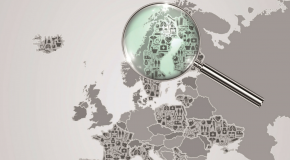Healthcare perspectives from The Economist Intelligence Unit
Racism is a public health issue
Related content

Value-based healthcare in Sweden: Reaching the next level
The need to get better value from healthcare investment has never been more important as ageing populations and increasing numbers of people with multiple chronic conditions force governments to make limited financial resources go further.
These pressures, along with a greater focus on patient-centred care, have raised the profile of VBHC, especially in European healthcare systems. Sweden, with its highly comprehensive and egalitarian healthcare system, has been a leader in implementing VBHC from the beginning, a fact that was underscored in a 2016 global assessment of VBHC published by The Economist Intelligence Unit.
This paper looks at the ways in which Sweden has implemented VBHC, the areas in which it has faced obstacles and the lessons that it can teach other countries and health systems looking to improve the value of their own healthcare investments.

Breast cancer patients and survivors in the Asia-Pacific workforce
With more older women also working, how will the rising trend of breast cancer survivorship manifest in workplace policies, practices and culture? What challenges do breast cancer survivors face when trying to reintegrate into the workforce, or to continue working during treatment? How can governments, companies and society at large play a constructive role?
This series of reports looks at the situation for breast cancer survivors in Australia, New Zealand and South Korea. It finds that while progress has been made, more needs to be done, particularly in South Korea, where public stigma around cancer remains high.
The Cost of Silence
Cardiovascular diseases levy a substantial financial toll on individuals, their households and the public finances. These include the costs of hospital treatment, long-term disease management and recurring incidence of heart attacks and stroke. They also include the costs of functional impairment and knock-on costs as families may lose breadwinners or have to withdraw other family members from the workforce to care for a CVD patient. Governments also lose tax revenue due to early retirement and mortality, and can be forced to reallocate public finances from other budgets to maintain an accessible healthcare system in the face of rising costs.
As such, there is a need for more awareness of the ways in which people should actively work to reduce their CVD risk. There is also a need for more primary and secondary preventative support from health agencies, policymakers and nongovernmental groups.
To inform the decisions and strategies of these stakeholders, The Economist Intelligence Unit and EIU Healthcare, its healthcare subsidiary, have conducted a study of the prevalence and costs of the top four modifiable risk factors that contribute to CVDs across the Asian markets of China, Australia, Hong Kong, Japan, Singapore, South Korea, Taiwan and Thailand.
Download the report to learn more.
State of patient centricity 2020: Advancing from patient-first intentions to true co-creation
Patient centricity is a near-universal goal in pharmaceutical research and development, but one without a commonly accepted definition. The challenge now is putting it into practice and understanding its impact on clinical trials. This Economist Intelligence Unit study, sponsored by Medidata, draws on insights from patient advocates, leading pharmaceutical and clinical research industry executives and extensive desk research.
Related content

Value-based healthcare in Sweden: Reaching the next level
The need to get better value from healthcare investment has never been more important as ageing populations and increasing numbers of people with multiple chronic conditions force governments to make limited financial resources go further.
These pressures, along with a greater focus on patient-centred care, have raised the profile of VBHC, especially in European healthcare systems. Sweden, with its highly comprehensive and egalitarian healthcare system, has been a leader in implementing VBHC from the beginning, a fact that was underscored in a 2016 global assessment of VBHC published by The Economist Intelligence Unit.
This paper looks at the ways in which Sweden has implemented VBHC, the areas in which it has faced obstacles and the lessons that it can teach other countries and health systems looking to improve the value of their own healthcare investments.

Breast cancer patients and survivors in the Asia-Pacific workforce
With more older women also working, how will the rising trend of breast cancer survivorship manifest in workplace policies, practices and culture? What challenges do breast cancer survivors face when trying to reintegrate into the workforce, or to continue working during treatment? How can governments, companies and society at large play a constructive role?
This series of reports looks at the situation for breast cancer survivors in Australia, New Zealand and South Korea. It finds that while progress has been made, more needs to be done, particularly in South Korea, where public stigma around cancer remains high.
The Cost of Silence
Cardiovascular diseases levy a substantial financial toll on individuals, their households and the public finances. These include the costs of hospital treatment, long-term disease management and recurring incidence of heart attacks and stroke. They also include the costs of functional impairment and knock-on costs as families may lose breadwinners or have to withdraw other family members from the workforce to care for a CVD patient. Governments also lose tax revenue due to early retirement and mortality, and can be forced to reallocate public finances from other budgets to maintain an accessible healthcare system in the face of rising costs.
As such, there is a need for more awareness of the ways in which people should actively work to reduce their CVD risk. There is also a need for more primary and secondary preventative support from health agencies, policymakers and nongovernmental groups.
To inform the decisions and strategies of these stakeholders, The Economist Intelligence Unit and EIU Healthcare, its healthcare subsidiary, have conducted a study of the prevalence and costs of the top four modifiable risk factors that contribute to CVDs across the Asian markets of China, Australia, Hong Kong, Japan, Singapore, South Korea, Taiwan and Thailand.
Download the report to learn more.
The workplace response to neurological conditions: A focus on migraine, multiple sclerosis and Alzheimer’s disease
Migraine, multiple sclerosis (MS) and Alzheimer’s disease (AD) affect over 1.3bn people globally. The report The workplace response to neurological conditions looks at the impact of these three neurological conditions on both patients and carers in the workplace.
Related content

Value-based healthcare in Sweden: Reaching the next level
The need to get better value from healthcare investment has never been more important as ageing populations and increasing numbers of people with multiple chronic conditions force governments to make limited financial resources go further.
These pressures, along with a greater focus on patient-centred care, have raised the profile of VBHC, especially in European healthcare systems. Sweden, with its highly comprehensive and egalitarian healthcare system, has been a leader in implementing VBHC from the beginning, a fact that was underscored in a 2016 global assessment of VBHC published by The Economist Intelligence Unit.
This paper looks at the ways in which Sweden has implemented VBHC, the areas in which it has faced obstacles and the lessons that it can teach other countries and health systems looking to improve the value of their own healthcare investments.

Breast cancer patients and survivors in the Asia-Pacific workforce
With more older women also working, how will the rising trend of breast cancer survivorship manifest in workplace policies, practices and culture? What challenges do breast cancer survivors face when trying to reintegrate into the workforce, or to continue working during treatment? How can governments, companies and society at large play a constructive role?
This series of reports looks at the situation for breast cancer survivors in Australia, New Zealand and South Korea. It finds that while progress has been made, more needs to be done, particularly in South Korea, where public stigma around cancer remains high.
The Cost of Silence
Cardiovascular diseases levy a substantial financial toll on individuals, their households and the public finances. These include the costs of hospital treatment, long-term disease management and recurring incidence of heart attacks and stroke. They also include the costs of functional impairment and knock-on costs as families may lose breadwinners or have to withdraw other family members from the workforce to care for a CVD patient. Governments also lose tax revenue due to early retirement and mortality, and can be forced to reallocate public finances from other budgets to maintain an accessible healthcare system in the face of rising costs.
As such, there is a need for more awareness of the ways in which people should actively work to reduce their CVD risk. There is also a need for more primary and secondary preventative support from health agencies, policymakers and nongovernmental groups.
To inform the decisions and strategies of these stakeholders, The Economist Intelligence Unit and EIU Healthcare, its healthcare subsidiary, have conducted a study of the prevalence and costs of the top four modifiable risk factors that contribute to CVDs across the Asian markets of China, Australia, Hong Kong, Japan, Singapore, South Korea, Taiwan and Thailand.
Download the report to learn more.
Value-based healthcare in Sweden: Reaching the next level
The need to get better value from healthcare investment has never been more important as ageing populations and increasing numbers of people with multiple chronic conditions force governments to make limited financial resources go further.
More from this series
Related content

Value-based healthcare: A global assessment
Introduction
As increasing life expectancy, accompanied by the rise of chronic diseases, pushes up healthcare spending across the world, it has become clear to many policymakers and healthcare providers that a business-as-usual approach to cost containment is no longer sustainable. To continue (or in some cases start) delivering accessible, high-quality care, policymakers increasingly recognise the need to forge a link between healthcare costs and outcomes in order to improve value for patients.
In recent decades, healthcare systems in countries including the UK and US have worked towards measuring the relative cost efficiency and comparative effectiveness of different medical interventions. This approach, known as value-based medicine, followed the development of evidence-based medicine and expanded the concept to include an explicit cost-benefit analysis, with a focus on the value delivered to patients, rather than the traditional model in which payments are made for the volume of services delivered.
Nevertheless, making the shift to VBHC is far from easy, and the majority of countries are still in the early stages of assembling the enabling components for this new approach to healthcare. Implementing the components of VBHC requires a rethink of the overall quality of patient outcomes (and the longer-term benefit relative to the cost of an intervention), rather than just the quantity of treatments delivered. Given the deeply rooted culture of fee-for-service and supply-driven models, in which payments are made for every consultation or treatment, introducing new approaches will take time.
A few “frontier” countries are making impressive advances, with some evidence of the adoption of forward-thinking approaches. For example, the US Centers for Medicare & Medicaid Services (CMS) are in the process of shifting to value-based payments over the next five years through the introduction of bundled payments and other measures.1 In the European Union (EU), a collaborative of hospitals in the Netherlands, Santeon, is measuring patient outcomes using metrics created by the International Consortium for Health Outcomes Measurement (ICHOM),2 and the Organisation for Economic Co-operation and Development (OECD) is also starting to address areas such as payment systems, value in pharmaceutical pricing3 and the efficiency of healthcare delivery and the need for co-ordination of care.
However, many others—particularly lower- income countries, which are facing a range of development challenges—have yet to start out on this journey. With tremendous diversity in healthcare systems worldwide, some countries are bound to face bigger challenges than others in shifting to value-based models. Even for those that have started to make changes, decades- old practices and entrenched interests are difficult to dislodge.
This report summarises our findings in the assessment4 of VBHC alignment in 25 countries. Using indicators such as the existence of a high-level policy or plan for VBHC, the presence of health technology assessment (HTA) organisations or the presence of policies that promote bundled payments (where a single fee covers the anticipated set of procedures needed to treat a patient’s medical condition), this study intends to paint a picture of the enabling environment—from policies and institutions to IT and payments infrastructure—for VBHC alignment across a diverse set of countries.
The results of the analysis reveal a mixed picture, with considerable variations across countries. These range from those where pay-for- performance models and co-ordinated models of care are being introduced to countries where some of the basic tools needed to implement value-based care—from patient registries to HTA organisations—are still not in place.
The challenges are not to be underestimated. In many healthcare systems today, information about the overall costs of care for an individual patient, and how those costs relate to the outcomes achieved, is very difficult to find. As this study will show, health data infrastructure can be improved in most countries.
For example, data in disease registries that track the clinical care and outcomes of a particular patient population are often inaccessible, lack standardisation and/or are not linked to each other, if they exist at all. In some places, attempts to develop electronic health records have floundered. In others, they have been implemented but lack interoperability across different providers, which means that they are of limited use in facilitating co-ordinated, longitudinal care.
However, even in developing countries, adoption of aspects of VBHC can also be found. For example, Colombia’s recent health reforms include plans to organise health delivery into patient focused-units within 16 co-ordinated care programmes.5
By assessing the existence of core components of VBHC across countries, this study provides new insights into the state of the enabling environment for value-based care around the world.
Download whitepaper for further details.

Value-based healthcare in Europe: Laying the foundation
Value-based healthcare looks at health outcomes of treatment relative to cost. In this particular report The EIU examines the way in which value is interpreted across the continent, the extent to which European countries are adopting cost-effectiveness as a key criterion for assessing it, and the efforts to develop new models for pricing innovation.
Further reading:
An introduction to value-based healthcare in Europe Value-based Health Assessment in Italy: A decentralised model Value-based healthcare in Germany: From free price-setting to a regulated market Value-based healthcare in Spain: Regional experimentation in a shared governance setting Value-based healthcare in France: A slow adoption of cost-effectiveness criteria Value-based healthcare in Portugal: Necessity is the mother of invention Value-based healthcare in the UK: A system of trial and error
Value-based healthcare in Japan
Value-based healthcare looks at health outcomes of treatment relative to cost. In this particular report The EIU examines whether Japan's healthcare system delivers good value for money, its approach to pricing and reimbursement, and the evolution of a nascent system for health technology assessment (HTA).
Further reading:
An introduction to value-based healthcare in Europe Value-based Health Assessment in Italy: A decentralised model Value-based healthcare in Germany: From free price-setting to a regulated market Value-based healthcare in Spain: Regional experimentation in a shared governance setting Value-based healthcare in France: A slow adoption of cost-effectiveness criteria Value-based healthcare in Portugal: Necessity is the mother of invention Value-based healthcare in the UK: A system of trial and error Value-based healthcare in Europe: Laying the foundationEXPAND INFOGRAPHIC
How do definitions of women’s well-being vary by region, age and income? Our new infographic, sponsored by Merck Consumer Health explores.
Related content

Value-based healthcare in Sweden: Reaching the next level
The need to get better value from healthcare investment has never been more important as ageing populations and increasing numbers of people with multiple chronic conditions force governments to make limited financial resources go further.
These pressures, along with a greater focus on patient-centred care, have raised the profile of VBHC, especially in European healthcare systems. Sweden, with its highly comprehensive and egalitarian healthcare system, has been a leader in implementing VBHC from the beginning, a fact that was underscored in a 2016 global assessment of VBHC published by The Economist Intelligence Unit.
This paper looks at the ways in which Sweden has implemented VBHC, the areas in which it has faced obstacles and the lessons that it can teach other countries and health systems looking to improve the value of their own healthcare investments.

Breast cancer patients and survivors in the Asia-Pacific workforce
With more older women also working, how will the rising trend of breast cancer survivorship manifest in workplace policies, practices and culture? What challenges do breast cancer survivors face when trying to reintegrate into the workforce, or to continue working during treatment? How can governments, companies and society at large play a constructive role?
This series of reports looks at the situation for breast cancer survivors in Australia, New Zealand and South Korea. It finds that while progress has been made, more needs to be done, particularly in South Korea, where public stigma around cancer remains high.
The Cost of Silence
Cardiovascular diseases levy a substantial financial toll on individuals, their households and the public finances. These include the costs of hospital treatment, long-term disease management and recurring incidence of heart attacks and stroke. They also include the costs of functional impairment and knock-on costs as families may lose breadwinners or have to withdraw other family members from the workforce to care for a CVD patient. Governments also lose tax revenue due to early retirement and mortality, and can be forced to reallocate public finances from other budgets to maintain an accessible healthcare system in the face of rising costs.
As such, there is a need for more awareness of the ways in which people should actively work to reduce their CVD risk. There is also a need for more primary and secondary preventative support from health agencies, policymakers and nongovernmental groups.
To inform the decisions and strategies of these stakeholders, The Economist Intelligence Unit and EIU Healthcare, its healthcare subsidiary, have conducted a study of the prevalence and costs of the top four modifiable risk factors that contribute to CVDs across the Asian markets of China, Australia, Hong Kong, Japan, Singapore, South Korea, Taiwan and Thailand.
Download the report to learn more.
Country Infographics
Related content

Value-based healthcare in Sweden: Reaching the next level
The need to get better value from healthcare investment has never been more important as ageing populations and increasing numbers of people with multiple chronic conditions force governments to make limited financial resources go further.
These pressures, along with a greater focus on patient-centred care, have raised the profile of VBHC, especially in European healthcare systems. Sweden, with its highly comprehensive and egalitarian healthcare system, has been a leader in implementing VBHC from the beginning, a fact that was underscored in a 2016 global assessment of VBHC published by The Economist Intelligence Unit.
This paper looks at the ways in which Sweden has implemented VBHC, the areas in which it has faced obstacles and the lessons that it can teach other countries and health systems looking to improve the value of their own healthcare investments.

Breast cancer patients and survivors in the Asia-Pacific workforce
With more older women also working, how will the rising trend of breast cancer survivorship manifest in workplace policies, practices and culture? What challenges do breast cancer survivors face when trying to reintegrate into the workforce, or to continue working during treatment? How can governments, companies and society at large play a constructive role?
This series of reports looks at the situation for breast cancer survivors in Australia, New Zealand and South Korea. It finds that while progress has been made, more needs to be done, particularly in South Korea, where public stigma around cancer remains high.
The Cost of Silence
Cardiovascular diseases levy a substantial financial toll on individuals, their households and the public finances. These include the costs of hospital treatment, long-term disease management and recurring incidence of heart attacks and stroke. They also include the costs of functional impairment and knock-on costs as families may lose breadwinners or have to withdraw other family members from the workforce to care for a CVD patient. Governments also lose tax revenue due to early retirement and mortality, and can be forced to reallocate public finances from other budgets to maintain an accessible healthcare system in the face of rising costs.
As such, there is a need for more awareness of the ways in which people should actively work to reduce their CVD risk. There is also a need for more primary and secondary preventative support from health agencies, policymakers and nongovernmental groups.
To inform the decisions and strategies of these stakeholders, The Economist Intelligence Unit and EIU Healthcare, its healthcare subsidiary, have conducted a study of the prevalence and costs of the top four modifiable risk factors that contribute to CVDs across the Asian markets of China, Australia, Hong Kong, Japan, Singapore, South Korea, Taiwan and Thailand.
Download the report to learn more.
Breathing in a new era: a comparative analysis of lung cancer policies in Japan, South Korea and Taiwan
Lung cancer is the most fatal cancer worldwide. By 2050 the global burden of lung cancer is projected to increase to 3.8m new cases and 3.2m deaths per year, with the greatest burden expected in East Asia, at 1.7m new cases and 1.5m deaths.1
The Economist Impact report, "Breathing in a new era: a comparative analysis of lung cancer policies in Japan, South Korea and Taiwan," sponsored by MSD, evaluates the various policies impacting lung cancer care in the three countries under the following five domains:
18275
Related content

Value-based healthcare in Sweden: Reaching the next level
The need to get better value from healthcare investment has never been more important as ageing populations and increasing numbers of people with multiple chronic conditions force governments to make limited financial resources go further.
These pressures, along with a greater focus on patient-centred care, have raised the profile of VBHC, especially in European healthcare systems. Sweden, with its highly comprehensive and egalitarian healthcare system, has been a leader in implementing VBHC from the beginning, a fact that was underscored in a 2016 global assessment of VBHC published by The Economist Intelligence Unit.
This paper looks at the ways in which Sweden has implemented VBHC, the areas in which it has faced obstacles and the lessons that it can teach other countries and health systems looking to improve the value of their own healthcare investments.

Breast cancer patients and survivors in the Asia-Pacific workforce
With more older women also working, how will the rising trend of breast cancer survivorship manifest in workplace policies, practices and culture? What challenges do breast cancer survivors face when trying to reintegrate into the workforce, or to continue working during treatment? How can governments, companies and society at large play a constructive role?
This series of reports looks at the situation for breast cancer survivors in Australia, New Zealand and South Korea. It finds that while progress has been made, more needs to be done, particularly in South Korea, where public stigma around cancer remains high.
The Cost of Silence
Cardiovascular diseases levy a substantial financial toll on individuals, their households and the public finances. These include the costs of hospital treatment, long-term disease management and recurring incidence of heart attacks and stroke. They also include the costs of functional impairment and knock-on costs as families may lose breadwinners or have to withdraw other family members from the workforce to care for a CVD patient. Governments also lose tax revenue due to early retirement and mortality, and can be forced to reallocate public finances from other budgets to maintain an accessible healthcare system in the face of rising costs.
As such, there is a need for more awareness of the ways in which people should actively work to reduce their CVD risk. There is also a need for more primary and secondary preventative support from health agencies, policymakers and nongovernmental groups.
To inform the decisions and strategies of these stakeholders, The Economist Intelligence Unit and EIU Healthcare, its healthcare subsidiary, have conducted a study of the prevalence and costs of the top four modifiable risk factors that contribute to CVDs across the Asian markets of China, Australia, Hong Kong, Japan, Singapore, South Korea, Taiwan and Thailand.
Download the report to learn more.
Biopharma’s evolution: learnings from the pandemic for a revived regulatory landscape
By December 2020, several potential covid-19 vaccines were showing promise in clinical trials. And by the middle of 2021, a vaccine was available to the public. Very few people had been optimistic that such a feat could be achieved. In many ways, it was a perfect storm. The fast development of covid-19 vaccines benefited from years of previous research on related viruses and vaccine trials that used mRNA. It’s said the research matured at just the right time, and that mRNA technology would not have been ready even five years ago.
18207
Related content

Value-based healthcare in Sweden: Reaching the next level
The need to get better value from healthcare investment has never been more important as ageing populations and increasing numbers of people with multiple chronic conditions force governments to make limited financial resources go further.
These pressures, along with a greater focus on patient-centred care, have raised the profile of VBHC, especially in European healthcare systems. Sweden, with its highly comprehensive and egalitarian healthcare system, has been a leader in implementing VBHC from the beginning, a fact that was underscored in a 2016 global assessment of VBHC published by The Economist Intelligence Unit.
This paper looks at the ways in which Sweden has implemented VBHC, the areas in which it has faced obstacles and the lessons that it can teach other countries and health systems looking to improve the value of their own healthcare investments.

Breast cancer patients and survivors in the Asia-Pacific workforce
With more older women also working, how will the rising trend of breast cancer survivorship manifest in workplace policies, practices and culture? What challenges do breast cancer survivors face when trying to reintegrate into the workforce, or to continue working during treatment? How can governments, companies and society at large play a constructive role?
This series of reports looks at the situation for breast cancer survivors in Australia, New Zealand and South Korea. It finds that while progress has been made, more needs to be done, particularly in South Korea, where public stigma around cancer remains high.
The Cost of Silence
Cardiovascular diseases levy a substantial financial toll on individuals, their households and the public finances. These include the costs of hospital treatment, long-term disease management and recurring incidence of heart attacks and stroke. They also include the costs of functional impairment and knock-on costs as families may lose breadwinners or have to withdraw other family members from the workforce to care for a CVD patient. Governments also lose tax revenue due to early retirement and mortality, and can be forced to reallocate public finances from other budgets to maintain an accessible healthcare system in the face of rising costs.
As such, there is a need for more awareness of the ways in which people should actively work to reduce their CVD risk. There is also a need for more primary and secondary preventative support from health agencies, policymakers and nongovernmental groups.
To inform the decisions and strategies of these stakeholders, The Economist Intelligence Unit and EIU Healthcare, its healthcare subsidiary, have conducted a study of the prevalence and costs of the top four modifiable risk factors that contribute to CVDs across the Asian markets of China, Australia, Hong Kong, Japan, Singapore, South Korea, Taiwan and Thailand.
Download the report to learn more.
Climate change is one of the most complex threats to the health of our people and our planet. The Middle East is among the geographic areas most vulnerable to rising temperatures, air pollution, food and water insecurity and adverse weather events. Without considerable mitigation and adaptation efforts, the health and longevity of current and future generations will be severely impacted.
Related content

UAE recognises the need to act on climate change fast
By organising global events such as COP28, the UAE aspires to demonstrate its commitment to climate action and bolster its global influence. The nation has been stepping up its climate actions over the years, starting with it being the first nation among Gulf Co-operation Council (GCC) countries to ratify the Paris Agreement in 2016.1 Then in 2022, it announced its Net Zero by 2050 strategy, the first such initiative in the region. The introduction of “The COP28 UAE Declaration on Climate on Health” further underscored the UAE’s substantial efforts towards climate-change mitigation and sustainability, and the crucial connection between climate change and health.
The impacts of climate change in the UAE affect well-being
By integrating climate considerations into public-health practices, the UAE's health system can enhance its resilience to climate-change impacts and better prepare for any associated health risks. The impacts of climate change in the UAE and the Middle East are becoming increasingly evident. As a result of climate change, the region is experiencing extreme weather in the form of more prolonged droughts, increasing frequencies of hotspells, extreme precipitation and compound effects on water resources, which will affect agricultural production and water availability. Furthermore, projections indicate a decrease in winter precipitation, leading to dryness and desertification in the Middle East. Recent studies suggest a significant decline in precipitation and an increase in temperatures, exacerbating the water-shortage crisis in the Middle East's semi-arid and arid climate.2 All of this will affect public health and therefore people’s well-being.
Focusing on capacity and infrastructure
The UAE is taking steps to address climate-related health challenges. This will mean a focus on existing building blocks. We will need to build resilient health-care systems by focusing on upgrading our health-care infrastructure, capacity and preparedness. Identifying and addressing the UAE’s top health priorities, such as cardiovascular diseases, cancer and childhood obesity, will also be an essential part of strengthening health systems in order to mitigate and manage the health impacts of climate change.
And we must not forget about research, as much is still unknown. We need to prioritise research on climate-change-related health issues to inform evidence-based interventions, which will provide valuable insights for effective policy formulation. Moreover, leveraging information and communication technologies (ICT) can enhance the UAE's health-system response to climate change. The health system can improve preparedness and response to climate-related health challenges by using telemedicine, remote sensing and data analytics. These advancements can strengthen health-care delivery, increase adaptive capacity and promote resilience in the face of climate-change impacts.3
By focusing on all these priorities, health systems can enhance their capacity to respond to the health impacts of climate change, promote public-health resilience and contribute to sustainable development in the region.4
Health is not alone—calling out to other sectors
As climate change is a collective challenge which requires cross-sectoral collaborative efforts, health actors need to lean on other sectors to manage this system challenge. By integrating climate considerations into urban planning, cities can develop green spaces, pedestrian-friendly infrastructure and efficient public-transportation systems, which will improve air quality and well-being.5 The UAE is also diversifying its energy mix and reducing its dependence on traditional fossil fuels. Initiatives such as solar-power plants and user-owned solar-power generators are being implemented in selected UAE cities to introduce renewable energy. Research has also highlighted the potential of biofuels sourced from mangroves, underscoring the UAE's commitment to renewable energy.6 Furthermore, sustainable-agriculture practices can bolster food security and minimise the environmental impact of food production, thereby positively influencing public health. Practices such as conservation-agriculture techniques and integrated pest-management techniques are critical for ensuring food security and promoting environmental sustainability. Furthermore, embracing alternative proteins and food tech interventions offers a promising avenue to bolster food security. These innovations can diversify food sources, reduce reliance on traditional livestock and farming, and mitigate the environmental impact of food production. The UAE has also been exploring the use of ICT for smart and sustainable agriculture, to enhance productivity while minimising environmental impact.7
Engagement will be key
While these initiatives are needed, we must also improve multi-sector collaboration, public education and engagement in climate advocacy. Many stakeholders will be needed, but universities and educational institutions, as custodians of knowledge, can help facilitate students and faculty to engage and act on climate change.
A good example of multi-stakeholder engagement is the UAE Climate Change Research Network, which was created in January 2021 by the Ministry of Climate Change and Environment. It is dedicated to improving climate resilience in all sectors, which includes new research, addressing adaptive capabilities and improving public awareness of the implications of climate change. Currently, the network consists of five clusters: Climate Change and Public Health (which I lead), Climate Data and Modelling, Climate Change and Infrastructure, Climate Change and Terrestrial, Marine and Freshwater Ecosystems, and Climate Change and Food and Water Security.8 This network also actively contributes to the UAE's global climate-action initiatives.
Demonstrating regional leadership, the UAE is actively identifying and implementing effective strategies to enhance its health and broader systems in response to climate change. While acknowledging the imperative for acceleratered action, the UAE remains committed to driving positive change swiftly and decisively.
1 UAE Ministry of Climate Change and Environment. The United Arab Emirates’ First Long-Term Strategy (LTS) Demonstrating Commitment to Net Zero by 2050. 2023. Available at: https://unfccc.int/sites/default/files/resource/UAE_LTLEDS.pdf
2 Chandran, A., Basha, G. and Ouarda, T.B.M.J. (2015). Influence of climate oscillations on temperature and precipitation over the United Arab Emirates. International Journal of Climatology, 36(1), 225-235. https://doi.org/10.1002/joc.4339
3 Alkhaldi, M., Moonesar, I.A., Issa, S.T. et al. (2023). Analysis of the United Arab emirates' contribution to the sustainable development goals with a focus on global health and climate change. International Journal of Health Governance, 28(4), 357-367. https://doi.org/10.1108/ijhg-04-2023-0040
4 Gan, C.C.R., Banwell, N., Pascual, R.S., Chu, C. and Wang, Y.W. (2019). Hospital climate actions and assessment tools: a scoping review protocol. BMJ Open, 9(12), e032561. https://doi.org/10.1136/bmjopen-2019-032561
5 Amrousi, M., Paleologos, E., Caratelli, P. and Elhakeem, M. (2018). Are garden cities in the desert sustainable? International Review for Spatial Planning and Sustainable Development, 6A(1), 79-94. https://doi.org/10.14246/irspsd.6a.1_79)
6 Merheb, M., Matar, R., Marton, J.M., Youssef, K.A., Hodeify, R. and Shafiq, N. (2018). Alternative energy in the UAE: the potential of biofuels sourced from Ras Al Khaimah mangroves. Al Qasimi Foundation. https://doi.org/10.18502/aqf.0091
7 Bilali, H.E., Bottalico, F. and Palmisano, G.O. (2020). Information and communication technologies for smart and sustainable agriculture. 30th Scientific-Experts Conference of Agriculture and Food Industry, 321-334. https://doi.org/10.1007/978-3-030-40049-1_41
8 https://www.moccae.gov.ae/en/climate-change-research-network-about.aspx

Building a sustainable future: balancing growth, net-zero goals and public...
The investment case for embedding sustainability in public health is twofold. One, doing something now is better than doing something later—building resilient and low-carbon healthcare systems today will be less costly and allow us to meet future challenges. Two, some parts of the world, such as the Middle East with its abundance of solar energy, have the ability to transition to a different formula for energy access, storage and distribution while also becoming leaders in this field.
Making healthcare systems more sustainable is important to reaching national net-zero goals and supporting the wellbeing of populations. Healthcare systems around the world are facing a critical challenge: how to expand services to meet the growing health needs of populations while aligning with net-zero and sustainability targets.
Funding alternative models of care
Prevention is better than cure: To manage the growing demand for healthcare in a low-carbon and resilient way, we need to look at alternative models of care and how to fund these, emphasising prevention and delivering health within communities so that people don't have to go to a hospital.
The most low-carbon and resilient hospital is the one that doesn't exist, because you don't need it. While we need the hospitals we've got today to deliver the things that hospitals do best (specialised care and advanced medical diagnosis and treatment), much of healthcare can be provided in the home or community environment. Singapore, for example, is adopting a population health model, where hospitals and primary and community care systems are vertically integrated within a geographical area. This means that the hospital only gets used when needed, and most care happens at home or virtually through digital health and telemedicine solutions.1 If we could develop this approach in different parts of the world, and the Middle East is well positioned for this, we would create a much more robust system that could manage growing demand while improving health in communities.
Yet, when looking at the Middle East, we must consider how we can deliver better healthcare and universal access for all. There are large disparities in the resources within countries. Countries such as the UAE and Qatar are very well-resourced, while other parts of the region struggle to develop their healthcare system.
Embracing digital solutions: The covid-19 pandemic taught us that rapid change at scale is possible when required. The pandemic accelerated the adoption of telehealth and telemedicine in a way that we would never have seen otherwise. While telemedicine will never take away from the role of the healthcare professional, and there are circumstances where a face-to-face visit is necessary, many consultations are more accessible and convenient when conducted virtually, especially for patients living in rural or remote areas. The adoption of telemedicine has a measurable impact on the carbon footprint of healthcare. When we calculate the carbon footprint of telemedicine, we often focus on the reduction in travel; however, we are also saving valuable resources in the hospital. In the quest for digital adoption, we must ensure that ageing populations and populations without internet access are not left behind. Governments must be genuinely committed to ensuring everybody has access to education, health and other public services through access to the internet.
Building climate resilience: As seen during the covid-19 pandemic, infectious diseases cross borders. We need to strengthen surveillance mechanisms to know how the changing climate impacts disease transmission and respond to the increased risk of infectious diseases such as malaria and dengue. Access to water and energy are important public health issues. There is an incredible dependency across people and communities to ensure we manage our natural resources as best as possible.
Building resilient health systems requires global and regional collaboration. Initiatives such as twinning partnerships, where hospitals in very different parts of the world learn from each other's diverse environments, help support cross-border collaboration to contain, spread and manage climate events.2
In this together
Joint accountability: Improving the sustainability of the healthcare sector is a joint responsibility. Over 70% of the healthcare sector's carbon emissions arise in the supply chain.3 Therefore, engaging with suppliers is critical. We have some great examples from the UK National Health Service (NHS) where it is adapting the tendering process, requiring suppliers to publish a Carbon Reduction Plan, and holding them accountable to demonstrate change. The NHS is also working with suppliers through initiatives like the Evergreen Sustainable Supplier Assessment, to identify opportunities for decarbonisation and align on NHS net-zero ambitions.4
Expanding the role of healthcare professionals: All health professionals, whether hospital managers, public health professionals, community health workers, surgeons or occupational therapists, must embrace the challenge of balancing the growing demand for healthcare with sustainability targets. We all must apply a sustainability lens to our own practice, our way of doing things and, ultimately, every decision we make.
With every decision we make, we must reflect on two things: one—is it necessary? And two—does it improve the quality of care? For instance, with single-use items, we need to question whether we really need to use them as single-use items. Can they be designed for reuse? The same goes for prescribing. We know that some medicines don't add a huge amount of value. For many patients, it may be better to get more exercise or improve their diet. This shift in thinking will also require changing how we educate our healthcare professionals so that asking questions about lower-carbon alternatives and best practices becomes fundamental. We also need to embed sustainability into research initiatives.
Engaging Patients: Patients are a critical stakeholder group, often left out of the sustainability discussion. We need to actively engage patients in treatment and care decisions to understand what they would like and what they would find sustainable. Let's take patients with diabetes as an example. Many who take regular insulin injections and undergo ongoing monitoring feel guilty about the amount of consumption and waste produced and are asking if we can find something that will be better for the environment.
Moving forward
Measuring what matters: At the Geneva Sustainability Center, we've just developed the Sustainability Accelerator Tool (SAT), a benchmarking tool to support hospital and healthcare leaders in driving sustainable, low-carbon, equitable and resilient healthcare. The SAT measures typical environmental elements that apply to all sectors, such as buildings, transport, food and supply chain, but also elements specific to healthcare, like anaesthetic gases, medicines, infection control, single-use items and how we deal with waste. It's essential that, as healthcare professionals, we take accountability for these health-specific elements, because if the healthcare sector doesn't take action, nobody else will.5
A common sense of urgency: The bottom line is that the climate crisis is a health crisis. Now is the time for the healthcare sector to step up, because climate change is impacting the health of populations in every country and in every community. We need to start embracing sustainability and integrate it into everything we do. Everyone in the sector, from policymakers to healthcare workers and suppliers, has a role to play. Everyone involved needs to think about what this means in their area of influence and what they can do differently to contribute to a better climate.
1 Nurjono, M., Shrestha, P., Ang, I.Y.H. et al. Shifting care from hospital to community, a strategy to integrate care in Singapore: process evaluation of implementation fidelity. BMC Health Serv Res 20, 452 (2020). https://doi.org/10.1186/s12913-020-05263-w
2 WHO. Initiatives. Twinning Partnerships for Improvement. Available from https://www.who.int/initiatives/twinning-partnerships-for-improvement
3 Health Care without Harm. Health care’s climate footprint: How the health sector contributes to the global climate crisis and opportunities for action. 2019.
4 NHS UK. A Net Zero Supply Chain and Suppliers. National Health Service. Available from https://www.supplychain.nhs.uk/sustainability/net-zero-supply-chain-and-suppliers/
5 International Hospital Federation (IDF). Toolbox. Available from https://ihf-fih.org/what-we-do/geneva-sustainability-centre/sustainability-toolbox/
A guest blog from Sonia Roschnik, executive director, Geneva Sustainability Centre
Visit The longevity equation: climate resilience for health in the Middle East to learn more
The views and opinions expressed in this article are those of the authors and do not necessarily reflect the views of Economist Impact or any other member of The Economist Group. The Economist Group cannot accept any responsibility or liability for reliance by any person on this article or any of the information, opinions or conclusions set out in the article.

Positioning health at the forefront of climate negotiations
In December 2023, 49 health ministers and over 60 ministers from other ministries gathered in Dubai for the first inter-ministerial meeting on climate and health held at the annual United Nations climate change conference, COP. While long overdue, the adoption of a dedicated health day at COP28 was not a surprise, as the health impacts of climate change have never been as visible as they are today.
Much of the political discourse on climate change is around emissions, finance and technology, yet the impacts of climate change affect the health of everyone. This is evident in the global impact felt in 2023, the hottest year on record, during which increased death and disability from extreme temperatures were recorded across almost all regions.1 Last Summer, wildfires in Canada and Hawaii underscored the severity of climate-related events, leading to smoke-covered cities in North America and significant casualties in Hawaii. As I write, wildfires in Chile, exacerbated by the current heatwave, have already caused more than 100 deaths. Globally, flooding and superstorms are increasing the risk of disease outbreaks, while climate change-driven drought, impacting food production, exacerbates hunger and famine. In the Middle East, rising exposure to dust storms and water stress are growing concerns, highlighting the urgent need for climate action.
Health at COP28: a small step in the right direction
COP28 achieved notable health successes, including the Declaration on Climate and Health, advancements in the Global Goal on Adaptation (GGA), and consensus on establishing a Loss and Damage Fund to provide compensation for climate-vulnerable countries.
The Declaration on Climate and Health, formulated with input from governments in the months leading up to COP28, has garnered signatures from 149 countries to date. This widespread support signals acknowledgment of the crucial link between climate change and health, and the urgent need for action, along with emphasising the importance of preparing and strengthening health systems. The declaration also recognises that many sectors determine health. Clean air, water, sanitation, and access to nutritious food, play pivotal roles in safeguarding people's health.
Established under the Paris Agreement, the GGA aims to establish collective commitments and funding for national adaptation needs. Agreed upon for the first time at COP28, it includes language addressing the necessity to strengthen health systems, especially in vulnerable regions. Though the wording requires further strengthening with measurable targets, indicators, and clear accountability, and badly needs to be underpinned by appropriate levels of funding, this represents a positive step forward.
Countries that contribute the least to driving climate change are often those experiencing the worst impacts, but lack the time and resources to adapt and protect themselves. In some cases, the climate impacts are so extreme that adaptation isn't feasible. Developing nations have long called for funding to respond to the impacts from climate change that they haven’t been able to adapt to, and at COP28, we finally saw the operationalisation of the Loss and Damage Fund. While a crucial step in compensating vulnerable nations, the current pledge of US$700 million from wealthy nations only covers 0.2% of the projected annual need of US$400 billion.2
These measures signal recognition among countries of the link between climate change and health, and their readiness for action, however the negotiated outcomes from COP28 fall far short of the urgency and ambition required for effective climate response. Notably, fossil fuels were explicitly mentioned for the first time, with a commitment to transition away from them in the energy sector. However, it is far from a firm commitment to a full and just phase-out of fossil fuels, containing language that leaves loopholes and potential room for expanding oil and gas use.3
Maintaining momentum beyond COP28
A louder health voice in climate policy As the damaging impacts of climate change on health become increasingly evident, involving the health community in climate negotiations, and placing health at the heart of decision-making, is vital.
Approaching climate change through a health lens results in distinct policy decisions that directly benefit the health and wellbeing of people, locally and in the near term. Among the best examples is cutting air pollution and fossil fuel use. Even if technologies like carbon capture and storage could help control greenhouse gas emissions (this has not yet been demonstrated), they don't mitigate the harmful air pollution impacts of fossil fuel use. Air pollution currently kills around 7m people a year, and 99% of people on the planet breathe air that exceeds the World Health Organisation’s air quality guidelines.4 Eliminating fossil fuel use would both mitigate climate change and make a substantial difference to the impacts of air pollution. Similarly, transitioning to electric vehicles, alone, reduces greenhouse gas emissions but falls short of the extensive health benefits associated with active transport. Safe bikeways, sidewalks, and walking to public transportation, offer opportunities for physical activity and contribute to substantial health gains, as well as influencing mental and social well-being.
Despite record health-sector participation at COP28, with around 1,900 health professionals present, the fossil fuel sector had over 2,400 representatives.5 To ensure the health voice prevails, a well-organised and informed health community is essential. Integrating climate change into health training and advocating for health ministries to actively participate in shaping national commitments and policies that address climate change is crucial. We look forward to seeing an even greater, and increasingly well-informed, health presence at future COPs.
Investment in health systems Strengthening our health systems is imperative to respond to the challenges of a changing climate. All health professionals need necessary training, and hospitals and clinics require proper infrastructure for effective response to weather events.
Historically, public health relied on past weather patterns for planning interventions and requirements. We're now in a time when the past is not an indicator of what's happening in the future. Adapting to future changes necessitates a shift from traditional approaches. Public health systems need real-time data and modelling, and early warning systems to let them know what is coming, whether a heat wave, a storm or period of poor air quality, so they can then take action that protects people as well as possible.
We also need to acknowledge the scale of the challenge we are facing. We're currently on a trajectory towards a world that would see nearly 3°C of global warming over the pre-industrial era.6
All the disasters and health impacts we're seeing are at 1.5°C or less. We cannot adapt to a 3°C world. Strengthening health systems alone won't suffice; addressing emissions in energy, transportation, and food systems is essential to protect public health.
A necessary equitable pursuit Many people in the world lack access to basic primary healthcare. Healthier populations are more resilient to climate threats, which means we must invest in universal health coverage worldwide.
Solutions like renewable energy, solar power and wind power, can improve healthcare in remote or low-income areas. Solar power, for instance, provides an independent energy source for hospitals and clinics without a formal grid, enhancing healthcare accessibility.
For low-income and developing countries, scalable solutions are crucial. Wealthy nations, especially those contributing significantly to the climate crisis, have a responsibility to support vulnerable nations. While this is a moral imperative and necessary to ensure global health equity, it is also in every nation’s self-interest. The climate crisis transcends borders, and affects all of us. We must all step up and make a united global effort to ensure the well-being, and indeed survival, of us all.
References
1 United Nations. Hottest July ever signals ‘era of global boiling has arrived’ says UN chief. July 2023. Available from https://news.un.org/en/story/2023/07/1139162.2 Green Central Banking. ECB warns climate laggard banks of penalty escalation. December 2023. Available from https://greencentralbanking.com/2023/12/13/ecb-warns-climate-laggard-banks-of-penalty-escalation/3 Wise, Jacqui. COP28 decision to “transition away” from fossil fuels is hailed as milestone but loopholes are decried. BMJ 2023;383:p2941.4 WHO. Billions of people still breathe unhealthy air: new WHO data. April 2022. Available from https://www.who.int/news/item/04-04-2022-billions-of-people-still-breathe-unhealthy-air-new-who-data5 NPR. A record number of fossil fuel representatives are at this year's COP28 climate talks. December 2023. Available from https://www.wamc.org/2023-12-07/a-record-number-of-fossil-fuel-representatives-are-at-this-years-cop28-climate-talks6 SEI, Climate Analytics, E3G, IISD, and UNEP. (2023). The Production Gap: Phasing down or phasing up? Top fossil fuel producers plan even more extraction despite climate promises. Stockholm Environment Institute, Climate Analytics, E3G, International Institute for Sustainable Development and United Nations Environment Programme. https://doi.org/10.51414/sei2023.050
A guest blog from Jeni Miller, executive director, Global Climate and Health Alliance
Visit The longevity equation: climate resilience for health in the Middle East to learn more
The views and opinions expressed in this article are those of the authors and do not necessarily reflect the views of Economist Impact or any other member of The Economist Group. The Economist Group cannot accept any responsibility or liability for reliance by any person on this article or any of the information, opinions or conclusions set out in the article.
Musculoskeletal Injuries in Australia: Current Challenges and Opportunities
Musculoskeletal disorders (MSDs), affecting an estimated 1.71 billion people globally, are a leading cause of disability and rehabilitation needs, accounting for 149 million years lived with disability.1
Related content

Value-based healthcare in Sweden: Reaching the next level
The need to get better value from healthcare investment has never been more important as ageing populations and increasing numbers of people with multiple chronic conditions force governments to make limited financial resources go further.
These pressures, along with a greater focus on patient-centred care, have raised the profile of VBHC, especially in European healthcare systems. Sweden, with its highly comprehensive and egalitarian healthcare system, has been a leader in implementing VBHC from the beginning, a fact that was underscored in a 2016 global assessment of VBHC published by The Economist Intelligence Unit.
This paper looks at the ways in which Sweden has implemented VBHC, the areas in which it has faced obstacles and the lessons that it can teach other countries and health systems looking to improve the value of their own healthcare investments.

Breast cancer patients and survivors in the Asia-Pacific workforce
With more older women also working, how will the rising trend of breast cancer survivorship manifest in workplace policies, practices and culture? What challenges do breast cancer survivors face when trying to reintegrate into the workforce, or to continue working during treatment? How can governments, companies and society at large play a constructive role?
This series of reports looks at the situation for breast cancer survivors in Australia, New Zealand and South Korea. It finds that while progress has been made, more needs to be done, particularly in South Korea, where public stigma around cancer remains high.
The Cost of Silence
Cardiovascular diseases levy a substantial financial toll on individuals, their households and the public finances. These include the costs of hospital treatment, long-term disease management and recurring incidence of heart attacks and stroke. They also include the costs of functional impairment and knock-on costs as families may lose breadwinners or have to withdraw other family members from the workforce to care for a CVD patient. Governments also lose tax revenue due to early retirement and mortality, and can be forced to reallocate public finances from other budgets to maintain an accessible healthcare system in the face of rising costs.
As such, there is a need for more awareness of the ways in which people should actively work to reduce their CVD risk. There is also a need for more primary and secondary preventative support from health agencies, policymakers and nongovernmental groups.
To inform the decisions and strategies of these stakeholders, The Economist Intelligence Unit and EIU Healthcare, its healthcare subsidiary, have conducted a study of the prevalence and costs of the top four modifiable risk factors that contribute to CVDs across the Asian markets of China, Australia, Hong Kong, Japan, Singapore, South Korea, Taiwan and Thailand.
Download the report to learn more.



